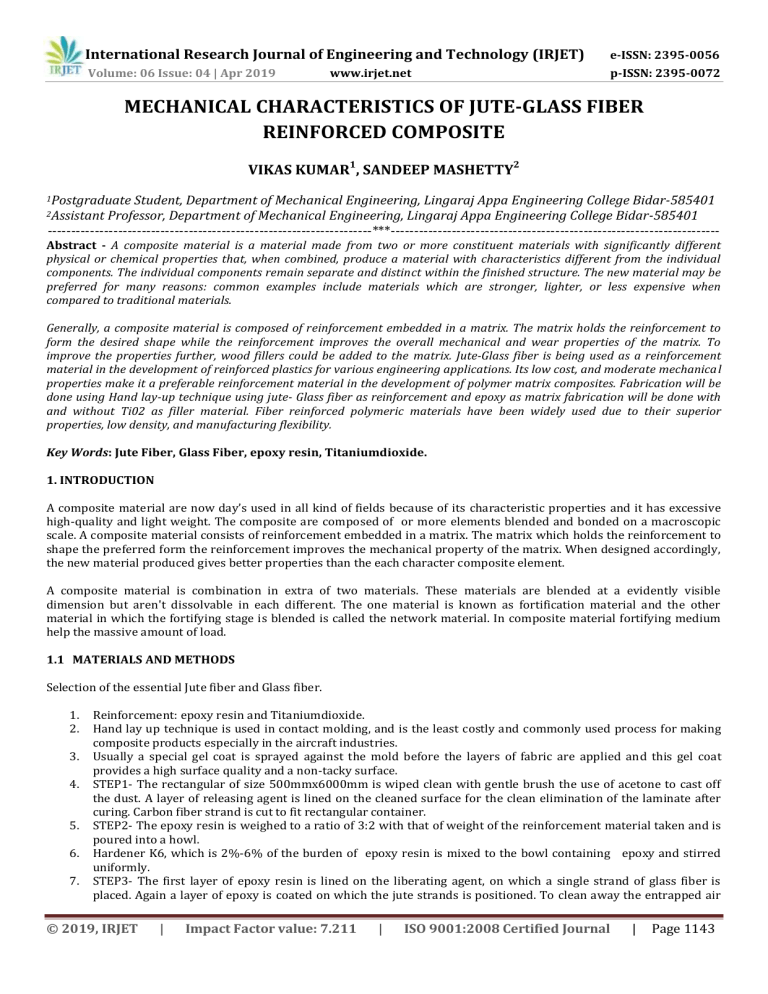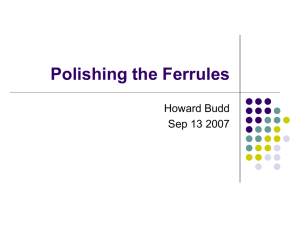IRJET-Mechanical Characteristics of Jute-Glass Fiber Reinforced Composite
advertisement

International Research Journal of Engineering and Technology (IRJET) e-ISSN: 2395-0056 Volume: 06 Issue: 04 | Apr 2019 p-ISSN: 2395-0072 www.irjet.net MECHANICAL CHARACTERISTICS OF JUTE-GLASS FIBER REINFORCED COMPOSITE VIKAS KUMAR1, SANDEEP MASHETTY2 1Postgraduate Student, Department of Mechanical Engineering, Lingaraj Appa Engineering College Bidar-585401 Professor, Department of Mechanical Engineering, Lingaraj Appa Engineering College Bidar-585401 ---------------------------------------------------------------------***---------------------------------------------------------------------- 2Assistant Abstract - A composite material is a material made from two or more constituent materials with significantly different physical or chemical properties that, when combined, produce a material with characteristics different from the individual components. The individual components remain separate and distinct within the finished structure. The new material may be preferred for many reasons: common examples include materials which are stronger, lighter, or less expensive when compared to traditional materials. Generally, a composite material is composed of reinforcement embedded in a matrix. The matrix holds the reinforcement to form the desired shape while the reinforcement improves the overall mechanical and wear properties of the matrix. To improve the properties further, wood fillers could be added to the matrix. Jute-Glass fiber is being used as a reinforcement material in the development of reinforced plastics for various engineering applications. Its low cost, and moderate mechanical properties make it a preferable reinforcement material in the development of polymer matrix composites. Fabrication will be done using Hand lay-up technique using jute- Glass fiber as reinforcement and epoxy as matrix fabrication will be done with and without Ti02 as filler material. Fiber reinforced polymeric materials have been widely used due to their superior properties, low density, and manufacturing flexibility. Key Words: Jute Fiber, Glass Fiber, epoxy resin, Titaniumdioxide. 1. INTRODUCTION A composite material are now day’s used in all kind of fields because of its characteristic properties and it has excessive high-quality and light weight. The composite are composed of or more elements blended and bonded on a macroscopic scale. A composite material consists of reinforcement embedded in a matrix. The matrix which holds the reinforcement to shape the preferred form the reinforcement improves the mechanical property of the matrix. When designed accordingly, the new material produced gives better properties than the each character composite element. A composite material is combination in extra of two materials. These materials are blended at a evidently visible dimension but aren't dissolvable in each different. The one material is known as fortification material and the other material in which the fortifying stage is blended is called the network material. In composite material fortifying medium help the massive amount of load. 1.1 MATERIALS AND METHODS Selection of the essential Jute fiber and Glass fiber. 1. 2. 3. 4. 5. 6. 7. Reinforcement: epoxy resin and Titaniumdioxide. Hand lay up technique is used in contact molding, and is the least costly and commonly used process for making composite products especially in the aircraft industries. Usually a special gel coat is sprayed against the mold before the layers of fabric are applied and this gel coat provides a high surface quality and a non-tacky surface. STEP1- The rectangular of size 500mmx6000mm is wiped clean with gentle brush the use of acetone to cast off the dust. A layer of releasing agent is lined on the cleaned surface for the clean elimination of the laminate after curing. Carbon fiber strand is cut to fit rectangular container. STEP2- The epoxy resin is weighed to a ratio of 3:2 with that of weight of the reinforcement material taken and is poured into a howl. Hardener K6, which is 2%-6% of the burden of epoxy resin is mixed to the bowl containing epoxy and stirred uniformly. STEP3- The first layer of epoxy resin is lined on the liberating agent, on which a single strand of glass fiber is placed. Again a layer of epoxy is coated on which the jute strands is positioned. To clean away the entrapped air © 2019, IRJET | Impact Factor value: 7.211 | ISO 9001:2008 Certified Journal | Page 1143 8. 9. International Research Journal of Engineering and Technology (IRJET) e-ISSN: 2395-0056 Volume: 06 Issue: 04 | Apr 2019 p-ISSN: 2395-0072 www.irjet.net and to reap uniform distribution of epoxy over the jute- glass fibers of the mat, hand operated rollers are rolled below consistent pressure during the mat floor. Same procedure is done again and again until the desired thickness is received. Alternate layers of glass and jute fiber are placed. STEP4- On the top most surface of the glass fiber a flat plate with same dimensions of laminate is placed. The pressure is applied manually for the extra epoxy resin to squeeze out from sides of the laminates. STEP5- The laminate is cured beneath mild pressure for two hrs, accompanied with the aid of curing at temperature for twenty-four hrs. By following the identical technique as stated above, composite laminates is ready. The mechanical behaviour and wear behavior of all the composite laminate are examined subsequently. 2. TEST RESULTS 2.1TENSILE TEST Tensile test was carried out on the Hounstill’s UTM in accordance with ASTM D638. Table 7.1 shows the details. 2.1 TENSILE TEST Table 1- Tensile test result Sl No. 1 2 3 Specimen Max. Load(N) Tensile stress at Extension at max load Modulus (N/mm2) J-G 16377.3 418.08 4.23 7416.49 J-G+%4 18430.75 455.37 4.86 6582.03 J-G+%8 18986.3 476.72 4.91 5831.87 In this examine, percentage of elongation, tensile electricity and tensile modulus at fracture of unfilled and TiO2 crammed jute glass fiber bolstered epoxy composites are plotted as a feature of TiO2 filler and the equal is proven in Fig 1, 2 and 3. Fig 1 suggests the share elongation of jute glass fiber bolstered epoxy composite with and without TiO2 filler.Fig.2 shows a linear growth in the tensile strength as the percentage of TiO2 accelerated. Fig 3 shows that, lower in modulus because the filler content in the composite is extended. Chart- 1 Extension at max load Chart - 2 Tensile stress © 2019, IRJET | Impact Factor value: 7.211 | ISO 9001:2008 Certified Journal | Page 1144 International Research Journal of Engineering and Technology (IRJET) e-ISSN: 2395-0056 Volume: 06 Issue: 04 | Apr 2019 p-ISSN: 2395-0072 www.irjet.net Chart -3 Modulus 2.2 FLEXURAL- TEST Flexural test was carried out on a universal testing machine. The readings are tabulated in table 2 Table 2 -Flexural- test results Sl No. 1 2 3 Specimen J-G J-G+%4 J-G+%8 Support Span (mm) 50 50 50 Max. Load(N) Max stress (N/mm2) Flexmodulus(N/mm2) 679.54 466.64 37757.46 1022.33 583.06 41408.63 654.32 398.76 33979.37 Chart 4- Max stress Chart 5- Flex modulus 2.3 SHORE-D HARDNESS Hardness test was carried out according to ASTM D-2240 and readings are tabulated in table 3. Table 3 –Shore-D- test results Sl No. 1 2 3 © 2019, IRJET | J-G 65 65 65 Impact Factor value: 7.211 J-G+%4 67 67 67 | J-G+%8 69 69 69 ISO 9001:2008 Certified Journal | Page 1145 International Research Journal of Engineering and Technology (IRJET) e-ISSN: 2395-0056 Volume: 06 Issue: 04 | Apr 2019 p-ISSN: 2395-0072 www.irjet.net Chart 6 – Shore-D vs Titanium dioxide 3. CONCLUSIONS Jute Glass fiber reinforcement and the add on of fillers to the epoxy matrix normally improved the mechanical properties of the composites. The following judgement are made: Jute Glass fiber strengthened epoxy composite with 8% TiO2 filler content material showed the most tensile strength and elongation, whereas most flexural power and modulus become acquired for J-G Composites of 4% TiO2 filler. An rise in hardness was determined with accelerated percentage of TiO2 filler in the composite. REFERENCES 1) Jartiz, A.E., Design 1965, pp. 18 2) Kelly, A. Sci. American 217, 1967, (B), 161 3) Berghezan, A. Nucleus, 8(5), Nonferrous materials, 1966, (Nucleus A. Editeur, l,rhe, Chalgrin, Paris 4) Van suchetclan, Philips Res. Repts. 1972, Vol.27, pp.28 5) Suresha, B., Chandramohan, G., Siddaramaiah, Sampathkumaran, P., and Seetharamu, S., “Three-body abrasive Wear behavior of Carbon and Glass fiber Reinforced Epoxy Composites”, Mater. Sci. Eng. (2007), A 443, pp. 285-292 6) A.P. Harsha and Sanjeev Kumar Jha., “Erosive Wear Studies of Epoxy based composites at normal incidence”, Wear 265 (2008) pp. 1129-1135 7) J. Stabik and A. Dybowska, Electrical and tribological properties of gradient epoxy graphite composites, JAMME, vol 27, March 2008, pp. 39-42 8) Lancaster, J.K., “The effect of carbon fiber reinforcement on friction and wear of polymers”, J. Appl. Phy1, (1968), pp. 549-555 9) V.K.Srivastava and A G Pawar, solid particle erosion of glass fiber reinforced flash filled epoxy resin composites, Composite Science and Technology, 2006, pp. 3021- 3028 10) N. Mohan , S. Natarajan, S.P.KumareshBabu, Siddaramaiah, Investigation on Two- Body Abrasive Wear Behavior of Silicon Carbide Filled Glass Fabric-Epoxy Composites , 2010, JMMCE, vol. 9/3, pp.231-246 11) B.Suresha, G.chandramohan, N.M. Renukappa, siddaramaiah, Mechanical and tribological properties of glass-epoxy composites with and without graphite particulate filler, Material Science Engg. 2007, vol. 103, pp.2472-2480 © 2019, IRJET | Impact Factor value: 7.211 | ISO 9001:2008 Certified Journal | Page 1146


